Panasonic Lumix G Vario 12-32mm f/3.5-5.6 ASPH. Lens Review
Panasonic Lumix G VARIO 12-32mm f/3.5-5.6 Performance
At 12mm sharpness in the centre of the frame is already outstanding, and the clarity towards the edges of the frame is not far behind. Stopping down is of little benefit as far as sharpness is concerned, anyway. There is a very slight improvement at f/4, but it is such a slight difference, it will be difficult to spot.Zooming to 18mm results in a slight reduction in sharpness, although excellent levels are still achieved at maximum aperture. Clarity raises to outstanding levels in the centre with the aperture stopped down to f/5.6.
Finally, at 32mm peak performance is realised at maximum aperture. Here sharpness is outstanding in the centre of the frame and falls just short of excellent levels towards the edges.
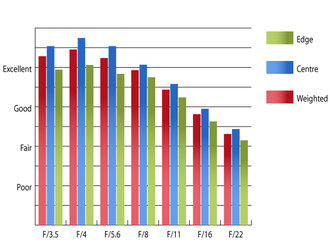 MTF@12mm | 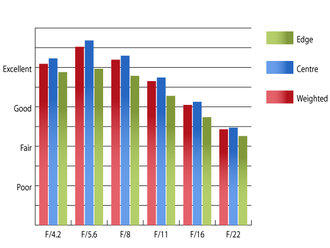 MTF@18mm |
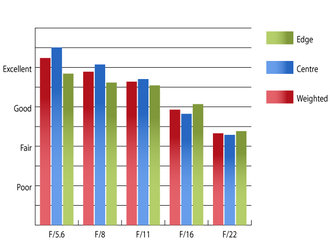 MTF@32mm | How to read our chartsThe blue column represents readings from the centre of the picture frame at the various apertures and the green is from the edges. Averaging them out gives the red weighted column.The scale on the left side is an indication of actual image resolution. The taller the column, the better the lens performance. Simple. For this review, the lens was tested on a Panasonic Lumix G3 using Imatest. |
Chromatic aberrations are pretty well controlled throughout most of the zoom range. Unfortunately they are not so well controlled at 12mm when shooting at the faster end of the aperture range. Here fringing exceeds 1.5 pixel widths, which may become visible along high contrast edges if images are printed at large sizes, or harsh crops are taken from the edges of the frame.
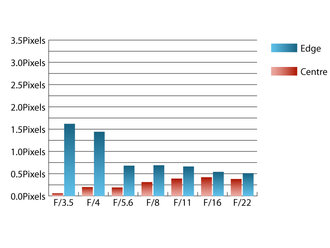 CA@12mm | 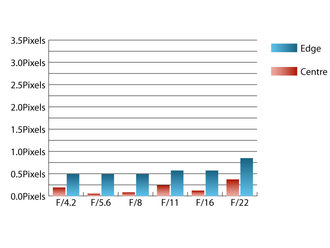 CA@18mm |
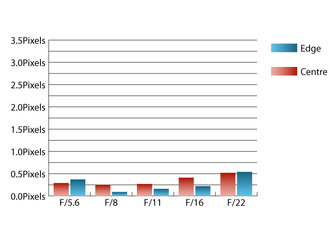 CA@32mm | How to read our chartsChromatic aberration is the lens' inability to focus on the sensor or film all colours of visible light at the same point. Severe chromatic aberration gives a noticeable fringing or a halo effect around sharp edges within the picture. It can be cured in software.Apochromatic lenses have special lens elements (aspheric, extra-low dispersion etc) to minimize the problem, hence they usually cost more. For this review, the lens was tested on a Panasonic Lumix G3 using Imatest. |
Falloff of illumination towards the corners is fairly typical for a standard zoom lens, and shouldn't pose too many issues. At 12mm and f/3.5 the corners are 1.47 stops darker than the centre of the image and stopping down to f/5.6 results in visually uniform images. At 32mm, and f/5.6 falloff is reduced and the corners are only 0.846 stops darker than the image centre and stopping down to f/8 results in visually uniform illumination.
Distortion is extremely well controlled with only 0.973% barrel distortion at 12mm being replaced with only 0.276% pincushion distortion at 32mm. This low level of distortion should rarely require correction, but if it does, the distortion pattern is uniform across the frame throughout the zoom range, which should make applying corrections in image editing software afterwards, relatively straightforward.
No hood is supplied with this lens, probably because there is nowhere to attach it, also it would add to the bulk of the lens. Shooting into the light is no problem for this optic and it proved itself resistant to flare during testing.
Add your message
Login required
Please login here or if you've not registered, you can register here. Registering is safe, quick and free.
Please login here or if you've not registered, you can register here. Registering is safe, quick and free.
photodo Stats
1102 lenses
428 MTF tests
74 in-depth photodo reviews
100+ users join each day
Help the lens community by reviewing or rating a lens today via our lens search
428 MTF tests
74 in-depth photodo reviews
100+ users join each day
Help the lens community by reviewing or rating a lens today via our lens search
Latest Lens Reviews
- Chinon 28mm f/2.8 Vintage Lens Review
- Canon EF 70-200mm f/4L IS II USM Lens Review
- Samyang AF 85mm f/1.4 EF Review
- Sigma 70mm f/2.8 DG Macro Art Review
- Samyang AF 24mm f/2.8 FE Review
- Meike 50mm f/1.7 Review
- Tamron 70-210mm f/4 Di VC USD Review
- Lensbaby Burnside 35mm f/2.8 Review
- Asahi Super Takumar 50mm f/1.4 Review
- Asahi Super-Multi-Coated Takumar 135mm f/3.5 Review
